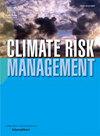Australia’s National Climate Risk Assessment: Identifying climate risk interdependencies within the infrastructure and built environment system for effective climate adaptation
IF 4.8
2区 环境科学与生态学
Q1 ENVIRONMENTAL SCIENCES
引用次数: 0
Abstract
Despite efforts to reduce greenhouse gas emissions, there are unavoidable impacts of climate change that are occurring now and will continue to unfold into the future. As the frequency and intensity of climate disasters increase, improving our understanding of climate risks will be critical for developing effective national climate adaptation actions. In recognition of the need for greater interdisciplinary and cross-sector collaboration to improve our understanding of systemic climate risks, a broad range of decision-makers across government and non-government organisations were engaged to identify Australia’s nationally significant risks through Australia’s first National Climate Risk Assessment (NCRA). In this paper, we describe the collaborative process developed for Australia’s NCRA and highlight the climate risk interdependencies identified for the infrastructure and built environment (I&BE) system. The I&BE system was chosen to illustrate the need to consider climate risk interdependencies, as this system’s sectors are heavily interconnected and fundamental to the functioning of critical infrastructure, essential services and supply chains. Using data collected through Australia’s NCRA, we illustrate how climate hazards create risks to individual I&BE sectors and how such risks aggregate, compound and/or cascade to form systemic risks. These systemic risks impact not only the I&BE system but also other systems, such as defence and national security, health and social support, and economy, trade and finance. Due to the high interdependencies of climate risks across sectors and systems, cross-sector collaboration is critical to address the interconnectedness of the systems and to develop effective climate adaptation strategies. A systemic approach to address climate risks will allow for response strategies that benefit multiple sectors simultaneously and reduce the likelihood of unforeseen negative compounding and cascading risks and maladaptation.
澳大利亚国家气候风险评估:确定基础设施和建筑环境系统中的气候风险相互依存关系,以实现有效的气候适应
尽管我们努力减少温室气体排放,但气候变化的影响不可避免,这些影响现在正在发生,并将在未来继续发展。随着气候灾害发生频率和强度的增加,提高我们对气候风险的认识对于制定有效的国家气候适应行动至关重要。由于认识到需要加强跨学科和跨部门合作,以提高我们对系统性气候风险的理解,澳大利亚政府和非政府组织的广大决策者参与了澳大利亚首次国家气候风险评估(NCRA),以确定澳大利亚的国家重大风险。在本文中,我们将介绍澳大利亚国家气候风险评估(NCRA)的合作流程,并重点介绍为基础设施和建筑环境(I&BE)系统确定的气候风险相互依存关系。选择 I&BE 系统是为了说明考虑气候风险相互依存性的必要性,因为该系统的各个部门之间相互联系紧密,对关键基础设施、基本服务和供应链的运作至关重要。利用澳大利亚国家气候风险评估收集的数据,我们说明了气候灾害如何给单个I&BE部门带来风险,以及这些风险如何累积、复合和/或串联形成系统性风险。这些系统性风险不仅影响 I&BE 系统,也影响其他系统,如国防和国家安全、卫生和社会支持以及经济、贸易和金融。由于气候风险在各部门和各系统之间的高度相互依存性,跨部门合作对于解决各系统之间的相互关联性和制定有效的气候适应战略至关重要。采用系统性方法应对气候风险,可以制定出同时惠及多个部门的应对战略,并降低不可预见的负面复合风险和级联风险以及适应不良的可能性。
本文章由计算机程序翻译,如有差异,请以英文原文为准。
求助全文
约1分钟内获得全文
求助全文
来源期刊

Climate Risk Management
Earth and Planetary Sciences-Atmospheric Science
CiteScore
8.20
自引率
4.50%
发文量
76
审稿时长
30 weeks
期刊介绍:
Climate Risk Management publishes original scientific contributions, state-of-the-art reviews and reports of practical experience on the use of knowledge and information regarding the consequences of climate variability and climate change in decision and policy making on climate change responses from the near- to long-term.
The concept of climate risk management refers to activities and methods that are used by individuals, organizations, and institutions to facilitate climate-resilient decision-making. Its objective is to promote sustainable development by maximizing the beneficial impacts of climate change responses and minimizing negative impacts across the full spectrum of geographies and sectors that are potentially affected by the changing climate.
 求助内容:
求助内容: 应助结果提醒方式:
应助结果提醒方式:


